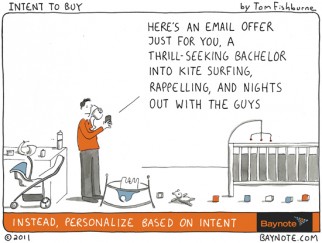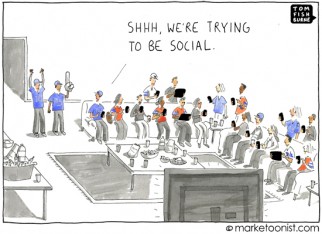How we execute matters a lot more than which tactics we execute.
A few years ago, I helped launch the method brand in the UK. We thought sampling would help tell the brand story person-to-person. We soon discovered that most in-store sampling treated all brands the same. The sampling staff did their jobs, but it was obvious that our brand was just one of many. They had sampled oatmeal the day before and were sampling a new potato crisp flavor the next day. We were just the brand du jour.
So we set out to make our sampling remarkable. Instead of the off-the-shelf samplers, we found performance artists looking for extra work in between acting, singing, and dancing gigs (via a brilliant agency called Mash). We trained dozens of performance artists to represent the method brand. They took it as seriously as if they were taking on an acting role.
Grocery chain Tesco wouldn’t let us bring our own samplers, so we focused on DIY retailer Homebase who were more flexible. We even manned a 24-day consumer event called the Ideal Home Show. The performance artists were so persuasive and engaging, we didn’t have to give away free samples. Instead, we sold our products for full price at the stand, ultimately selling enough to cover the cost of the show. It was self-funding marketing.
At one point in the show, I spotted a sampling team for Persil, a competitor brand. They stood in the middle of the hall, frantically stuffing free samples into people’s over-stuffed bags without a word. It became just another free sample, lost in the clutter. Persil’s sampling budget dwarfed ours, but their impact was significantly less.
Many marketing tactics run on autopilot. Yet there’s always an opportunity to elevate marketing tactics to performance art.
(Marketoonist Monday: I’m giving away a signed print of this week’s cartoon. Just share an insightful comment to this week’s post. I’ll pick one comment by 5:00 PST on Monday. Thanks!)



Kevin Francis says
Tom,
Thanks for the illuminating case study. Brings to mind 2 things for me…
1. Chapter 13 of “Scientific Advertising” by Claude Hopkins is titled “Use of Samples”. His key comments…”Give samples to interested people only. Give them only to people who exhibit that interest by some effort. Give them only to people to whom you have told your story. First create an atmosphere of respect, a desire, an expectation.”
2. Re the performance artists, that brought to mind the classic “boardwalk pitchmen” and their infomercial successors. There’s a great video “Gadgetmania” from Discovery Channel that contains some classic pitches that any marketer can benefit from.
Thanks as always for the cartoon and the post!
Copywriter Kevin Francis
Vince Skolny says
When we use autopilot marketing tactics, more often than not we end up marketing a commodity and the only way to differentiate a commodity is through price competition.
It’s customer experiences that create the preferences and expectations that grow demand and give us competitive options beyond eating away the bottom line.
Blair Smith says
Tom,
Another great example. It captures the essence of others you’ve shared and where more of the marketing discussion should be focused. Sampling, TV, direct mail, social are all channels. If the message isn’t relevant it won’t connect with the audience. If the creative you’re pushing is poor it will just add to the “clutter”.
Deliver a good message in an interesting way and you give your brand a better chance of getting into the head and heart of the audience. Bring more art into the equation to balance the scientific.
Really enjoy your stuff!
Blair Smith
@blairaasmith
Olivia says
Clever! I love the idea of hiring Performance Artists. As an outsourced marketing company, we conduct a number of Retail Road Shows for BJ’s, Costco, etc. and will consider this option.
From this cartoon, I’m also reminded of the book “How” by Dov Seidman.
Judy Anderson says
Hi there-
I immediately thought of nonprofits working to try and connect people to their mission and work. So often, auto-pilot programs become the norm, and the goal of making memories, connections, and building a sense of community get’s lost in the shuffle.
Thanks-
Kat Krieger says
Thanks Tom, this is funny and very true! It really speaks to why lifestyle/venue sampling can be more memorable, particularly with staff that is more educated and passionate about a brand. Method is such a great case study all around. @brandconnection @katskrieger
Paul Copcutt says
Bag stuffing samplers rank up there for me alongside card throwing networkers!
You do occasionally come across the paid sample – where the cost of the sample is covered and refunded if you make a full size purchase. I have found that the food samplers at Costco seem to have a sales mindset, you try the the food and they are directing you to the product and taking about the offer connected to it.
But when they are busy they are just focused with getting the sample in your hands, I know of parents who take their kids to the large grocery stores or even Costco just before lunch so they can shop and feed the kids at the same time – now that really does hurt the sampling budget!
Just my toonies worth!
Larry Burns says
“Many a true word is spoken in jest.” ~English Proverb or perhaps “Comedy has to be based on truth. You take the truth and you put a little curlicue at the end.” ~Sid Caesar
Either is right on the mark. ” …just another free sample, lost in the clutter” is a sad commentary but it can happen in spite of great intentions.
In truth, Sampling Works because nothing trumps first hand experience of a brand – period full stop. But if that “experience” is not conscious or welcomed / desired – then maybe we can understand why some brands still assume (using internal benchmarks) that ‘trial rates’ (% of samples distributed that are just even tried let alone purchase dynamics) are as low as the 60s or 70s in other words embarrassingly low.
Samples can be a boon to a brands adoption in their market – but mindful, clear thought about what and why and how we are sampling is paramount. Sampling can without question be done right, effectively and yield amazing results – your Method example is proof of that pudding…
Yet, it is a bit shameful when I see something that just should not be – @ a college football game seeing spilled boxes of fragrance samples littering a parking lot – or a bored demonstrator – or a soggy pile of ___ left out – … or .. or …. However, at the same time I can also point to highly engaged and energetic demonstrators, great online campaigns, engaged interested people wowed by the brands and .. and … and. The ideas are never the issue – its about how we get it done …
Thanks for the humor … it is much appreciated. @JlarryBurns
Comedy is simply a funny way of being serious. ~Peter Ustinov
tomfishburne says
Great perspective this week, many thanks!
This week’s cartoon goes to Kevin Francis. I love the simple rule of thumb from Scientific Advertising. It’s amazing how often that’s overlooked.
Thanks!
-Tom